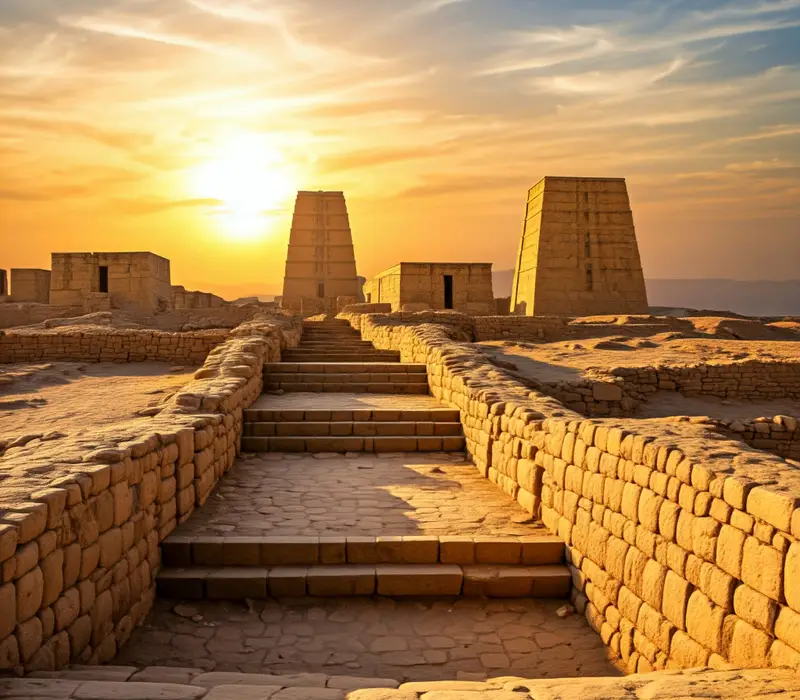The Ancient City of Lagash: A Forgotten Gem of Mesopotamia

Lagash, also spelled "Lajash" or "Lakash," is an ancient city located in present-day Iraq, with its ruins now known as Tell al-Hiba. Situated between Basra and Uruk, this ancient city played a vital role in Sumerian civilization and flourished during the first half of the third millennium BCE. Its location in the fertile lands of southern Iraq helped make it a prominent center for agriculture, religious activities, and early state organization. provides a deep dive into the fascinating history of Lagash, exploring its rise, peak, and eventual decline.
Location and Historical Importance
Lagash was located west of the modern town of Karma near Basra and east of the ancient city of Uruk. The city site, now called Tell al-Hiba, lies about 45 km northeast of Nasiriyah, a region in southern Iraq. Archaeological surveys indicate that the city rose on the remains of an earlier Ubaid period village, dating to the 4th millennium BCE.
During the Early Dynastic period (2800–2350 BCE), Lagash achieved significant prominence and became a thriving urban center. It was known as Uruku-ga, which translates to "The Sacred City" in the Sumerian language. The city's religious, agricultural, and political importance peaked during this era, with its influence extending over a large portion of southern Mesopotamia.
Urban Growth and Religious Complexes
Lagash saw considerable development in the Early Dynastic period, as evidenced by the large-scale religious structures found in the ruins. Temples dedicated to the gods Ningirsu (the god of war and agriculture) and Nanna (the moon god) were central to the city's spiritual and social life. The city's priests and rulers played a critical role in managing both the religious and administrative aspects of daily life.
Temples and Religious Life
The temple of Ningirsu was among the most significant religious structures in Lagash. Ningirsu was not only the protector deity of the city but also represented agricultural prosperity, an essential part of the region's economy. In addition, other temples honored Nanna, demonstrating the diverse religious practices that shaped Lagash's identity.
The growth of temple complexes during this period reflects the importance of religion in shaping social and political life in Lagash. These sacred spaces were also economic hubs, where temple officials managed land, labor, and the distribution of resources to ensure the city's prosperity.
Administrative and Political Power
Excavations at Tell al-Hiba uncovered an impressive administrative building containing cuneiform tablets. These tablets mention several rulers of Lagash, including two prominent kings: E-anatum and En-anatum I. These leaders expanded the city's influence, often engaging in warfare with neighboring city-states. They left behind inscriptions celebrating their victories and building projects, which offer valuable insights into the political dynamics of the time.
Population and Economy
The population of Lagash during its peak is estimated to have ranged between 19,000 and 36,000 inhabitants, with the city's surrounding territories supporting nearly 100,000 people. Agriculture formed the backbone of the economy, with crops such as barley, wheat, and dates cultivated using irrigation systems. Lagash was also known for its livestock and textile production, contributing to trade with other Mesopotamian cities.
Decline and Abandonment
By the mid-3rd millennium BCE, Lagash began to lose its political and economic influence. The city gradually declined, likely due to competition from other Sumerian centers like Ur and Uruk. Archaeological evidence suggests that although the site attracted some inhabitants in the early 2nd millennium BCE, it was ultimately abandoned and forgotten in the historical record.
Lagash’s disappearance from cuneiform texts signals the end of its era as a major city-state. However, the city's agricultural practices, religious traditions, and administrative innovations left a lasting mark on Mesopotamian civilization.
The Legacy of Lagash in Mesopotamian History
Lagash’s legacy, like that of many other Sumerian cities, lies in its contributions to agriculture, religion, and governance. The religious practices and administrative systems developed in Lagash would shape the development of future Mesopotamian empires. Although the city was abandoned, it remains a key archaeological site, offering scholars valuable insights into the earliest urban societies.
Exploring Lagash Today: A Journey into Iraq's Past
Travelers visiting Iraq today can explore the ancient ruins of Lagash at Tell al-Hiba, located within a short distance from Nasiriyah. Though the site may not be as well-known as Ur or Babylon, it offers a unique glimpse into the world of ancient Sumerians. Iraq’s southern region, where Lagash is located, provides a rich cultural and historical experience, especially for those interested in the origins of human civilization.
Visitors can combine a trip to Lagash with a tour of nearby archaeological sites, such as the Great Ziggurat of Ur and Uruk. These sites collectively reveal the grandeur of ancient Mesopotamian culture, making the journey to southern Iraq an unforgettable experience for history enthusiasts.